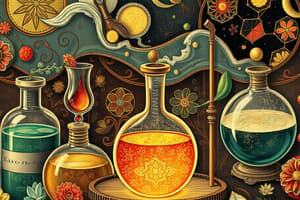Podcast
Questions and Answers
_______ _______ is a representation of a chemical reaction with reactants on the left, products on the right, and an arrow separating the two.
_______ _______ is a representation of a chemical reaction with reactants on the left, products on the right, and an arrow separating the two.
chemical equation
__________ _______ is a chemical equation that does not indicate the relative amounts of the reactants and products.
__________ _______ is a chemical equation that does not indicate the relative amounts of the reactants and products.
skeleton equation
What is a catalyst?
What is a catalyst?
A substance that speeds up the reaction but is not used up in the reaction.
A ______ is a small whole number ratio that is placed in front of the formulas in an equation in order to balance it.
A ______ is a small whole number ratio that is placed in front of the formulas in an equation in order to balance it.
A _______ ______ is an equation where each side of the equation has the same number of atoms of each element, and mass is conserved.
A _______ ______ is an equation where each side of the equation has the same number of atoms of each element, and mass is conserved.
Iron + oxygen ---> iron (III) oxide is an example of a(n) _______ ____.
Iron + oxygen ---> iron (III) oxide is an example of a(n) _______ ____.
Fe + O2 ---> Fe2O3 is an example of a(n) _______ _______.
Fe + O2 ---> Fe2O3 is an example of a(n) _______ _______.
What do (s), (g), (l), and (aq) stand for?
What do (s), (g), (l), and (aq) stand for?
What is a combination reaction?
What is a combination reaction?
What is a decomposition reaction?
What is a decomposition reaction?
What is a single replacement reaction?
What is a single replacement reaction?
What is a double replacement reaction?
What is a double replacement reaction?
What is a combustion reaction?
What is a combustion reaction?
What are the five general types of chemical reactions?
What are the five general types of chemical reactions?
What is the law of conservation of mass?
What is the law of conservation of mass?
How many general types of chemical reactions are there?
How many general types of chemical reactions are there?
When does a chemical reaction occur?
When does a chemical reaction occur?
What does the arrow in a reaction mean?
What does the arrow in a reaction mean?
What are the elements that only exist on their own as diatomic molecules?
What are the elements that only exist on their own as diatomic molecules?
What is the memory device to remember the elements that only exist on their own as diatomic molecules?
What is the memory device to remember the elements that only exist on their own as diatomic molecules?
Flashcards are hidden until you start studying
Study Notes
Chemical Reactions Overview
- A chemical equation represents a chemical reaction, with reactants on the left and products on the right, separated by an arrow.
- A skeleton equation shows the formulas without indicating the amounts of reactants or products.
Key Definitions
- Catalyst: A substance that accelerates a reaction without being consumed.
- Coefficient: Whole numbers placed before formulas in balanced equations to ensure mass conservation.
- Balanced equation: An equation that has equal numbers of atoms for each element on both sides, conserving mass.
Types of Reactions
- Combination reaction: Two or more substances combine to form a new substance.
- Decomposition reaction: A single compound breaks down into two or more simpler products.
- Single replacement reaction: An element replaces another in a compound.
- Double replacement reaction: Positive ions are exchanged between two compounds.
- Combustion reaction: A substance reacts with oxygen, releasing heat and light.
Representations of Chemical Reactions
- Word equation: Describes reactants and products using words (e.g., Iron + oxygen → iron(III) oxide).
- Chemical equation: Uses chemical symbols and formulas (e.g., Fe + O₂ → Fe₂O₃).
- Complete ionic equation: Shows dissolved ionic compounds as free ions.
- Net ionic equation: Displays only participating ions directly involved in the reaction.
Activity Series
- A list of metals ordered by their reactivity, crucial in predicting the outcomes of single replacement reactions.
Writing Chemical Equations
- To write a word equation, list reactants on the left, products on the right, separated by plus signs.
- For a skeleton equation, place the chemical formulas of reactants and products appropriately around the yield sign (arrow).
- Balanced chemical equations maintain mass conservation, adhering to the Law of Conservation of Mass.
Special Considerations
- Diatomic molecules: Certain elements (H, N, F, O, I, Cl, and Br) naturally exist as diatomic molecules. A mnemonic is "Never Have Fear Of Ice Cold Beer".
- Endothermic reactions absorb heat, whereas exothermic reactions release heat.
- Spectator ions do not participate in the chemical change and appear unchanged on both sides of the equation.
Examples
- Synthesis reaction: 2CO + O₂ → 2CO₂.
- Decomposition reaction: 2HgO → 2Hg + O₂.
- Combustion reaction: CH₄ + 2O₂ → CO₂ + 2H₂O.
Understanding Chemical Reactions
- A chemical reaction occurs during the transformation of reactants into products.
- The arrow (→) signifies yielding or producing new substances.
These points provide a concise overview of the essentials in chemical reactions, including types, terminology, and key concepts important for understanding chemical processes.
Studying That Suits You
Use AI to generate personalized quizzes and flashcards to suit your learning preferences.




